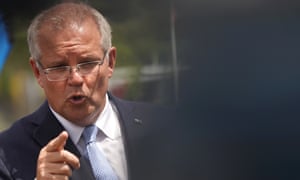As clouds on the economic horizon darken, Scott Morrison has many problems and little to brag about
We
have less than 100 days to go until the most likely date for the
election of 18 May. Political parties try to use their first 100 days to
frame their government; failed ones try to use the last 100 to reframe
it, which is exactly what the Morrison government is doing.
Right now the government is going all in on a fear campaign about what will happen under Labor. They’re coming for your retirement income, they will flood the country with asylum seekers and potential terrorists, they will destroy the value of your home.
The old adage that “everyone hates fear campaigns, but they work” is very much in place.Right now the government is going all in on a fear campaign about what will happen under Labor. They’re coming for your retirement income, they will flood the country with asylum seekers and potential terrorists, they will destroy the value of your home.
The government has many problems right now: most voters don’t understand why the leader they have is in that job; the two Coalition parties are riven with internal discord; they have no climate change policy; they have overseen a catastrophe in the Murray-Darling Basin; they are under attack in their safest seats from independents; and people don’t much fear Bill Shorten.
But the main reason they’re trying to reframe the campaign with fear is because they have little to brag about. Unfortunately, they are running their fear campaign in perhaps the shonkiest manner possible.
A year ago things were looking up – 2017 had seen a surge of employment growth, and the Liberal party under Turnbull could have argued that the hard yards were over, the payoff of their policies in the form of higher incomes was coming.
And yet now the clouds on the economic horizon are darkening and we might be about to be hit with economic rain, without having even experienced a brief moment of sunshine.
Take the statements of the governor of the Reserve Bank, Philip Lowe.
In June 2017 he noted that “wage growth remains low and this is likely to continue for a while yet”.
So, not good.
A year ago in the first statement in 2018 Lowe noted that “wage growth remains low. This is likely to continue for a while yet, although the stronger economy should see some lift in wage growth over time.”
So not good but it should get better ... over time.
This week when announcing that the RBA was keeping interest rates at 1.5%, he noted: “The stronger labour market has led to some pick-up in wages growth, which is a welcome development. The improvement in the labour market should see some further lift in wages growth over time, although this is still expected to be a gradual process.”
So “still over time”, still “a gradual process”. Just wait, it’s coming... maybe. Be patient.
But the government cannot be patient. It has less than 100 days, and more importantly it has had five years, and in those five years, while they have had success on employment and better budget numbers, households are no better off – indeed many find their economic situation is worse.
The former public servant David Plunkett, who spends more time looking at the impact of changes in the tax and transfer system on incomes than just about anyone, has estimated that during the Turnbull/Morrison government most income earners have become worse off in real terms, and the poorest are the worst affected.
This accords with my own findings that average employee contributions and average household disposable incomes are at 2010 levels in real terms, and about the best anyone can say is that they will get better ... over time ... but it’s a gradual process.
Not the type of things that looks good on a campaign bumper sticker.
The problem for the government is that the Reserve Bank believes the outlook is much less positive than the government is estimating for its budget revenue forecasts.
I have long been sceptical about the government’s claims that wages will return to growing above 3% per annum within a year or two. The latest budget figures suggest by June 2020 wage growth will hit 3% and 3.5% the following year. Not only do those figures suggest a rosiness of economic activity, they also suggest a nice boost in income tax revenue.
The Reserve Bank however doesn’t have to worry about pumping up budget numbers or winning elections and on Wednesday, Lowe revealed a chart in a speech to the National Press Club that had wages growing by just 2.5% and 2.75% in 2020 and 2021.
That “gradual process” looks like at least three years.
On Friday the Reserve Bank also released its latest statement on monetary policy and it contained a large downgrading of its growth forecasts. It took its forecast for GDP growth for this year from 3.25% to 3% and for the 2019-20 financial year from 3.25% to 2.75%.
Boasting that their economic management has not resulted in better living standards or much hope of better ones in the next three years is not going to win votes.
And so the switch has well and truly been flicked to negative.
Less than a hundred days to go. A hundred days of fear about the economy to disguise the lack of achievement.

No comments:
Post a Comment